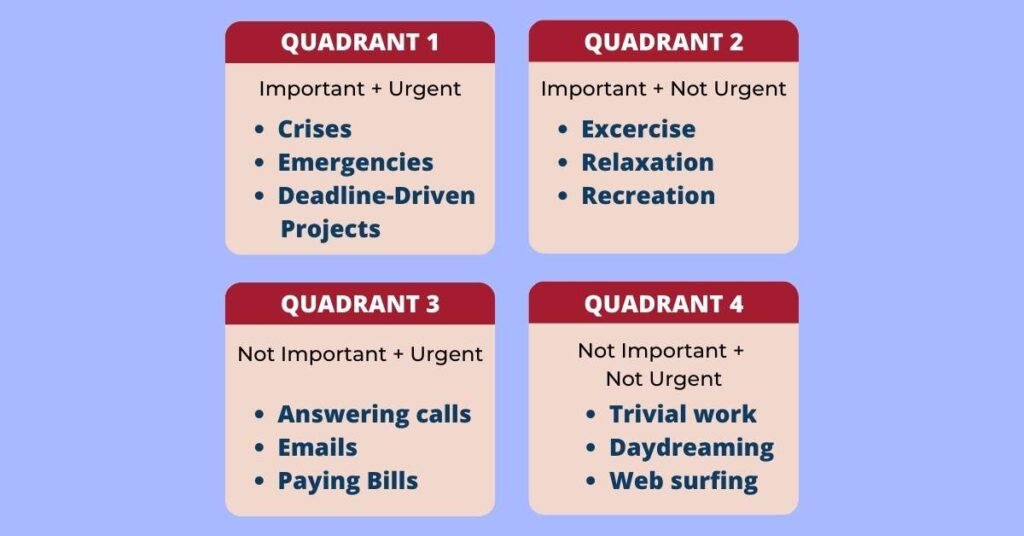Time is what drives our life and it is the progress of the events of the past, the present, and the future. Hence, we must learn how to manage it effectively.

Efficient time management and optimization help us spend our days in productive ways and allocate them for essential elements of our life such as work, friends, family, and self-care.
Time is not something that can be stored up and used later. It can only be saved and managed in the best way possible. It is a commodity that if used properly can make our lives far easier and convenient.
What Is Time Management

Time Management is the way that you organize and plan, how long you spend on specific activities. The right way to designate or delegate our time to every task at hand is effective time management.
Pickle Jar Theory
One of the most popular theories to understand Time Management is the Pickle Jar Theory that was designed by Proactive scheduler, Jeremy Wright. It was also used by American educator, Stephen Covey in his book, 7 Habits of Highly Effective People.
The Pickle Jar Theory tells us how to divide or segregate all the tasks that we do in a day into a glass jar. It suggests prioritizing tasks and responsibilities in a specific order of importance.

To make it more simple, the pickle jar resembles our typical day, while the sand, pebbles, and rocks represent everyday tasks.
To explain the theory in further detail, here’s what type of everyday activities the sand, the pebbles, and the rocks represent:
- The sand represents all the small things such as represents all the phone calls, emails, social media notifications, chatting with colleagues, and other disruptions that affect productivity at work.
- The pebbles metorphorically stand for the jobs that we are confronted with every day and that fill our diaries. For. eg. Cooking, Travelling, Getting to office, etc.
- The rocks signify the most important tasks in our daily lives. There will be serious consequences if we fail to complete these tasks on time. This includes sending reports to your seniors, interacting with clients, major projects that depend on your contributions, etc.

This is an experimental theory that helps you plan your day in a much more effective way,
Hence, you complete the major tasks of your day first (rocks), followed by your comparatively less important activities (pebbles) while delegating or postponing all the other things for later (sand).
Time Management Matrix

As mentioned earlier, the Time Management Matrix was proposed by Stephen Covey in his book, 7 Habits of Highly Effective People.
It is a tool used to identify the importance and urgency of our daily tasks and segregate them accordingly. The matrix is represented with four quadrants that form a mix of tasks that are Urgent, Important, Not Urgent, and Not Important.
These combinations help us to characterize every task into four types mentioned as follows:
- Urgent And Important
- Important And Not Urgent
- Not Important And Urgent
- Not Important And Not Urgent
Let us understand all these types in more detail further.
Type 1 – Urgent And Important
The tasks that fall under the first quadrant are those which may lead to serious consequences if we fail to accomplish them.

These tasks are crisis, emergencies, urgent medical or family issues, pressing problems, deadline-driven projects or meetings, some calls, etc. These are the activities that require your utmost focus and attention.
While trying to complete these tasks one might burn out or experience a tremendous amount of stress. Hence, it is crucial to identify urgent and important tasks and tackle them.
Type 2 – Important And Not Urgent
The second quadrant characterizes tasks that are quite important in nature yet are not something that needs your immediate attention.

These tasks include exercise, vocation, presentation, planning, relation-building, prevention, clarification of values, recreation, and relaxation.
You have to decide when you do these tasks accordingly. Being in this state brings a clear vision, perspective, fine balance, discipline, and control to an individual.
Type 3 – Not Important And Urgent
The third quadrant helps us define activities that are urgent yet not so important. It becomes clear that these tasks are something that is needed to be delegated to someone else or delayed for later.

These tasks include interactions with colleagues answering calls/texts, uninteresting chat with individuals, non-essential emails, payment of dues and bills, etc. These activities usually have a high dependency on others and hence hinder productivity on a personal level.
Type 4 – Not Important And Not Urgent
The tasks in the last quadrant are particularly known as Time Wasters. This is due to the nature of these tasks being quite simple and dull.

These activities include trivial work, overthinking or daydreaming, excessive web surfing, substance abuse, etc.
The entire time management matrix helps you to identify where you are spending most of your time and hence analyze and reprioritize.
The 4 D’s of Time Management

The 4 D’s of Time Management circle backs to the Pickle Jar Theory and the Time Management Matrix and explains fours ways to add, remove or manage our tasks in a much more effective way. The 4 D’s are:
- Delete It – You have to learn to delete certain things that cannot to be fit in your to-do list.
- Delegate It – You have to seek help of others and delegate tasks that you cannot accomplish.
- Do It – With the unnecessary clutter of tasks, now is the time to accomplish your important tasks.
- Defer It – This states to delay important activities that you have to complete at a later point of time.
Type of Time Wasters – How To Identify And Eliminate Them
We live in a world with constant distractions and time-wasters. Hence, it is crucial to identify these elements and eliminate them for reprioritizing tasks and managing time. Following is a classification of time-wasters and ways to get rid of them:
Telephone

- Use voice mail and set aside time to return calls.
- Avoid small talk. Stay focused on the reason of the call.
- Stand up while you talk on the phone. You are more likely to keep the conversation brief.
- Set aside times of the day for recieving calls and let others know when you are unavailable.
Meetings

- Know the purpose and agenda of the meeting in advance.
- Arrive on time.
- Start and end the meeting on time.
- Stand up in meetings.

- Set aside a specific time to view and respond to your e-mail, but don’t let it accumulate to the point that it becomes overwhelming to sort.
- Set up folders and rules in your email.
- Try to handle each relevant email only once, read and respond immediately.
- Delete junk e-mail immediately from your electronic mailbox.
Family Obligations

- Establish a master calendar for each family member to post their time commitments.
- Make each family member responsible for consulting the master calendar for potential conflicts.
- Create a central area for posting communications such as appointment reminders, annoucements, and messages.
Others

- Let people know when you are available to meet visitors.
- Close web pages after you have finished reading them.
- Don’t distract yourself with mobile games.
- Turn off social media at work.
- Learn to say no.
Exercises To Eliminate Time Wasters

Part 1
- Take a moment to think about your tasks all day.
- Write down on a sheet of paper: things you do on a daily basis aside from the tasks you are supposed to carry out as part of your job.
- Scribble down on different parts of sheet rather than making a list.
Part 2
- Now start tearing off bits of each paper containing one ‘time-waster’
- What is left off after tearing off all the ‘time-wasters’ is where you need to spend your limited time.
Part 3
- Ask yourself, how does that make you feel?
- Analyse which slips of paper are your worst time bandits? Why?
- Brainstrom some possible solutions.
Effective time management is difficult but achievable! We hope that with these comprehensive articles with techniques you will be able to identify and manage your tasks based on their level of importance and boost your productivity. Share your thoughts about time management in the comments section.
t
Author
-

Ashwin Dewan is the Co-founder and Managing Director of Indian School of Image Management. He has had a dynamic career of 15+ years that reflects the pioneering experience and year-on-year success in achieving business growth objectives in well-established organizations.
View all posts





[…] Related Article: Time Management 101 – Effective Tips For Managing Time […]
[…] Related Article: Time Management 101 – Effective Tips For Managing Time […]